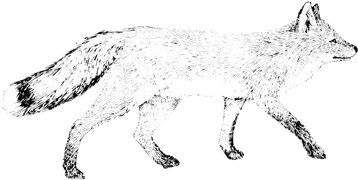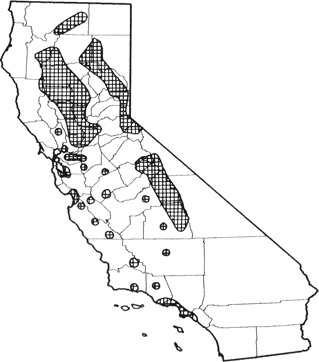
Red Fox
Distribution, Abundance, and Seasonality
Rare in Sierra Nevada, but widely distributed in lowlands in central and southern California. The native subspecies V. v. necator is found in Cascades, in Siskiyou Co., and from Lassen Co. south to Tulare Co. Introduced populations inhabit Sacramento and San Joaquin valleys and scattered coastal and inland locations from Sonoma Co. south to Monterey Co., and east to Stanislaus Co., as well as in Ventura, Los Angeles, and Orange cos. Sierra Nevada populations may be found in a variety of habitats, including alpine dwarf-shrub, wet meadow, subalpine conifer, lodgepole pine, red fir, aspen, montane chaparral, montane riparian, mixed conifer, and ponderosa pine. Jeffrey pine, eastside pine, and montane hardwood-conifer also are used. Populations in central and southern California occur in annual and perennial grassland, coastal scrub, wet meadow, emergent wetland, and cropland habitats, and may use mixed chaparral and chamise-redshank chaparral (Grinnell et al. 1937, Ingles 1965, Ewer 1973, Ables 1975, Gray 1975,1977, Schempf and White 1977, Gould 1980). Most sightings in Sierra Nevada above 2200 m (7000 ft), ranging from 1200-3700 m (3900-11,900 ft) (Schempf and White 1977). Sightings in central and southern California below 914 m (3000 ft) (Schempf and White 1977).

Range Map
Specific Habitat Requirements
Feeding: Hunts small and medium-sized mammals, ground squirrels, gophers, mice, marmots, woodrats, pikas, and rabbits. Apparently an increasingly important predator of ground-nesting waterfowl, shorebirds, upland game birds, and eggs in lowland California and other areas. Other vertebrates, insects, carrion, fruits, and earthworms used occasionally; carrion important in winter, as are lagomorphs. Hunts in meadows, fell-fields, grasslands, wetlands, and other open habitats. Caches food (Scott 1955, Scott and Klimstra 1955, Sargent 1972, 1978, Ewer 1973, MacDonald 1980, Maccarone and Montevecchi 1981, Samuel and Nelson 1982, Yoneda 1982).
Cover: Uses dense vegetation and rocky areas for cover and den sites.
Reproduction: Den sites include rock outcrops, hollow logs and stumps, and burrows in deep, loose soil (Grinnell et al. 1937, Ables 1975). May move pups to new den several times.
Water: Captive red foxes did not require free water as pups or adults (Sargent 1978).
Pattern: In Sierra Nevada, prefers forests interspersed with meadows or alpine fell-fields. Open areas are used for hunting, forested habitats for cover and reproduction. In lowlands, uses fence lines, hedgerows, woodlots, and other brushy, wooded areas for cover and reproduction, and hunts in cropland, wetland, urban habitats and other open areas (Grinnell et al. 1937. Ables 1975, Samuel and Nelson 1982).
Species Life History
Activity Patterns: Active yearlong; hunts day and night (Grinnell et al. 1937, Ables 1975).
Seasonal Movements / Migration: None in many habitats. Sierra red foxes move downslope in winter into ponderosa pine and mixed conifer, upslope in summer to lodgepole pine, subalpine conifer, alpine dwarf-shrub, and red fir habitats (Grinnell et al. 1937, Schempf and White 1977).
Home Range: Summer home ranges in alpine and subalpine tundra of British Columbia averaged 1611 ha (3979 ac), varying from 277-3420 ha (684-8447 ac) (Jones and Theberge 1982). In Minnesota, lllinois, and Wisconsin, home ranges averaged 700 ha (1728 ac) and varied from 155-1554 ha (384-3840 ac) (Sargent 1972, Storm et al. 1976). Red foxes have been known to travel up to 395 km (245 mi). Home range size is influenced by food abundance and habitat.
Territory: The male defends the territory, which is shared by the mated pair and pups. Defense consists of display, scent-marking, chasing, and rare physical conflict (Preston 1975). The entire home range may be defended, or territoriality may break down in times of food abundance (Orr 1971, Zarnoch et al. 1977, Samuel and Nelson 1982).
Reproduction: Mating takes place in late winter (January-March), and after a gestation period of 52 days, young born in early spring (March-May). Litter sizes in many studies averaged about 5. Most litters are 4-6, though range is 1-12 (Grinnell et al. 1937, Samuel and Nelson 1982). There is 1 litter/yr. Pups dependent on parents for 6 mo, and become sexually mature at 10 mo (Orr 1971, Zarnoch et al. 1977).
Niche: Coexists with coyotes in Sierra Nevada, and with gray and kit foxes and coyotes in lowland California. Numbers apparently increase when numbers of coyotes and other predators decrease, through predator control or natural factors (Schmidt 1986). Sierra Nevada populations apparently reduced by grazing in meadows, which reduces prey populations, and by trapping, logging, and recreational disturbance (Grinnell et al. 1937, Schempf and White 1977).
Comments: Sierra Nevada red foxes are rare, and numbers may be continuing to decline (Schempf and White 1977). Lowland populations, presumably introduced, are expanding in range and numbers (Gray 1977, Gould 1980).
Sources & References
California Department of Fish and Game, 1999.
California's Wildlife, Sacramento, CA.
Written by: V. Johnson, J. Harris, reviewed by: H. Shellhammer, edited by: R. Duke, S. Granholm
Ables, E. D. 1968. Ecological studies on red foxes in southern Wisconsin. Ph.D. Thesis, Univ. Wisconsin, Madison. 148pp. Ables, E. D. 1969a. Activity studies of red foxes in southern Wisconsin. J. Wildl. Manage. 33:145-153. Ables, E. D. 1969b. Home-range studies of red foxes (Vulpes vulpes). J. Mammal. 50:108-120. Ables, E. D. 1975. Ecology of the red fox in North America. Pages 216-236 in M. W. Fox, ed. The wild canids. Von Nostrand Reinhold, New York. 508pp. California Department of Fish and Game. 1980a. At the crossroads: a report on the status of California's endangered and rare fish and wildlife. Sacramento. 149pp. Ewer, R. F. 1973. The carnivores. Cornell Univ. Press, Ithaca, NY. 494pp. Gould. G. I., Jr. 1980. Status of the red fox in California. Calif. Dep. Fish and Game, Nongame Wildl. Invest., Sacramento. Prog. Rep., W-54-R-12. 3pp. Gray, R. L. 1975. Sacramento Valley red fox survey. Calif. Dep. Fish and Game, Nongame Wildl. Invest. Prog. Rep., Job II-1.2. 10pp. Gray, R. L. 1977. Extension of red fox distribution in California. Calif. Fish and Game 63:58. Grinnell, J., J. S. Dixon, and J. M. Linsdale. 1937. Fur-bearing mammals of California. 2 Vols. Univ. California Press, Berkeley. 777pp. Ingles, L. G. 1965. Mammals of the Pacific states. Stanford Univ. Press, Stanford, CA. 506pp. Jones, D. M., and J. B. Theberge. 1982. Summer home range and habitat utilization of the red fox (Vulpes vulpes) in a tundra habitat, northwest British Columbia, Canada. Can. J. Zool. 60:807-812. MacDonald, D. W. 1980. The red fox, Vulpes vulpes, as a predator upon earthworms, Lumbricus terrestris. Z. Tierpsychol. 52:171-200. Maccarone, A. D., and W. A. Montevecchi. 1981. Predation and catching of seabirds by red foxes (vulpes vulpes) on Baccalieu Island, Newfoundland, Canada. Can. Field-Nat. 95:352-353. Orr, R. T. 1971. Mammals of North America. Doubleday, New York. 250pp. Preston, E. M. 1975. Home range defense in the red fox. J. Mammal. 56:645-653. Samuel, D. E., and B. B. Nelson. 1982. Foxes (Vulpes vulpes and allies). Pages 475-490 in J. A. Chapman and G. A. Feldhamer, eds. Wild mammals of North America. Johns Hopkins Univ. Press, Baltimore, MD. 1147pp. Sargent, A. B. 1972. Red fox spatial characteristics in relation to waterfowl predation. J. Wildl. Manage. 36:225-236. Sargent, A. B. 1978. Red fox prey demands and implications to prairie duck production. J. Wildl. Manage. 42:520-527. Schempf, P. F., and M. White. 1977. Status of six furbearer populations in the mountains of northern California. U.S. Dep. Agric., For. Serv., San Francisco, Calif. 51pp. Schmidt, R. H. 1986. Community-level effects of coyote population reduction. Pages 49-65 in J. Cairns, Jr., ed. Community Toxicity Testing. Amer. Soc. Testing and Materials, Philadelphia, PA. Scott, T. G. 1955. Dietary patterns of red and gray foxes. Ecology 36:366-367. Scott, T. G., and W. D. Klimstra. 1955. Red foxes and a declining prey population. South. III. Univ. Monogr. Ser. No. 1, Carbondale. 123pp. Storm, G. L., R. D. Andrews, R. L. Phillips, R. A. Bishop, D. B. Sinniff, and J. R. Tester. 1976. Morphology, reproduction, dispersal, and mortality of midwestern red fox populations. Wildl. Monogr. No. 49. 82pp. Yoneda, M. 1982. Influence of red fox (Vulpes vulpes) predation on a local population of small rodents. Appl. Entomol. Zool. 17:308-318. Zarnoch, S. J., R. G. Anthony, and G. S. Storm. 1977. Computer simulated dynamics of a local red fox population. Pages 253-268 in R. L. Phillips and C. Jonkel, eds. Proceedings of the 1975 Predator Symposium. Montana. For. Conserv. Exp. Sta., Univ. Montana, Missoula. 268pp.
California Animal Facts | California's Wildlife